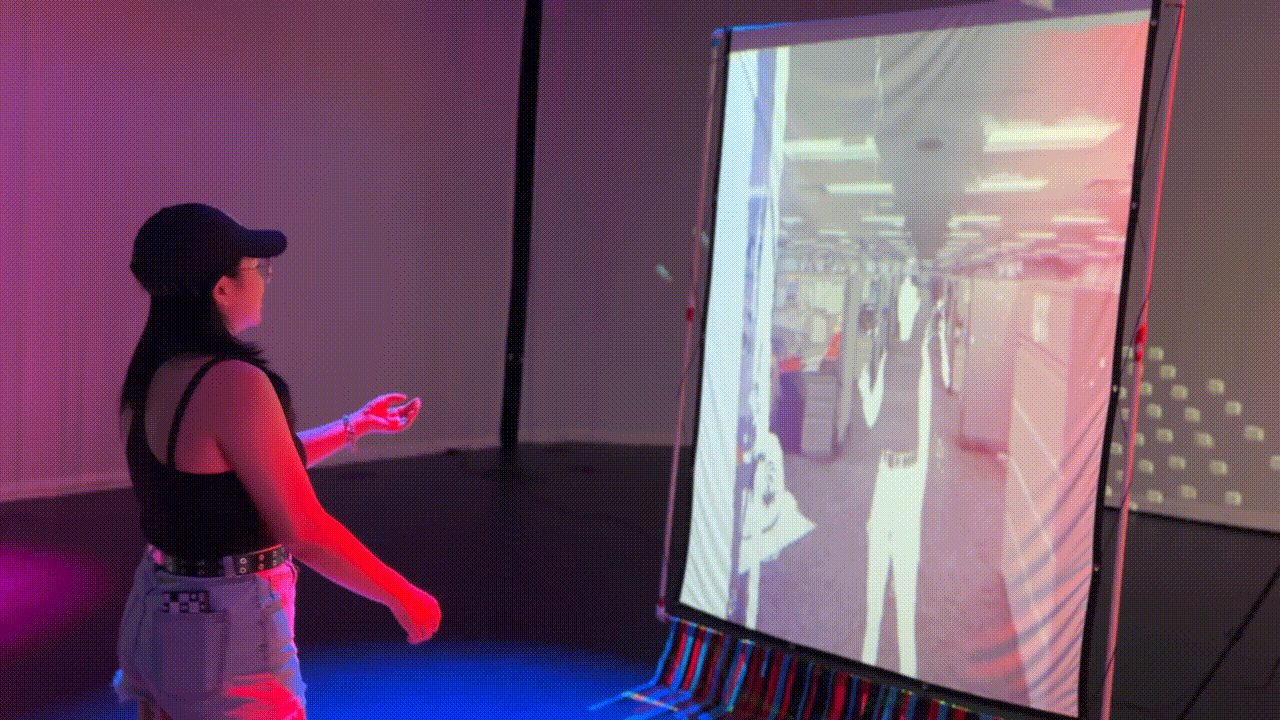Memory Management
A multi-sensory art experience integrating empathy and interaction with a hybrid technology approach.
KC Yeneza, Exhibition Technology Engineer and External Communications Coordinator
Zack Weaver, Mentor
Brad Gallagher, Mentor
Dahn Bi Chong, Concept Artist and Set Designer
Gabe Butler, Vintage Technology Engineer, Post Production Lead, and Creative Coding Architect
Esther San Diego, Voice Casting Coordinator, and Sound Designer
Created with MadMapper, TouchDesigner, Max/MSP, Resolume, Ableton, Premiere Pro, Python
Our story
Memory Management is an immersive, interactive art installation that invites viewers to enter the scattered world of Christine, a character navigating life transitions. As “Memory Inspectors,” participants are asked to investigate a memory breach that has disrupted Christine’s inner world.
Through a series of vintage technology artifacts, including a television, rotary phone, and interactive mirror, they uncover pieces of Christine’s memories.
At its core, Memory Management aims to hold space for empathy, allowing users to reflect on their own personal experiences, while finding common ground with others.
Mood boarding
Our team researched a variety of projects that aligned with our multidisciplinary approach. These works ranged from heavy design influences to narrative based pieces, providing valuable insights into how others conceptualize art installations.
Our take away: We were interested in older media devices, such as old TVs and radios so we enjoyed how this installation connects so many to bring one cohesive theme together.
Playback Theater Project | Playback Theater Project
Our take away: This type of project is hugely narrative based, and relies on the actor and audience relationship (the experience can never be recreated). However, we envisioned a different medium to present our story.
Ideation
(Concept art created by Dahn, to illustrate our ideas)
Challenge: How do we approach complex information hierarchy and layout decisions?
Solution: To organize a large amount of content into meaningful interactions, we used low-fidelity sketches to explore different layout structures.
Interaction Design
Our team developed 4 stations, with audio visual techniques to create a sensory-rich experience.
Background Projection
KC Yeneza
Challenge: How might I influence themes of movement and nostalgia?
Solution: I developed the background projection, which attempts to further immerse the user in a liminal space.
Tech stack: TouchDesigner, Resolume, 360 Projectors
I developed the visual backdrop using TouchDesigner for real-time generative art.
I further adjusted the colors and textures to better fit nostalgic themes.
Finally, using Resolume Arena I blended three projectors along a 360 scrim to display the piece.
Transforming Mirror
KC Yeneza, featuring Gabe Butler and Dahn Bi Chong
Challenge: How might we design moments of interaction and vulnerability?
Solution: I created a transforming mirror, designed to transport the viewer in an alternate environment, offering glimpses into spaces of Christine's core memories.
The Transforming Mirror acts as a portal, initially displaying a still image of an office space in standby. As a user approaches, their silhouette is overlaid onto the scene, triggering a transition into Christine’s memories accompanied by shifts in sound design.
Standby
In Motion
I curated images that replicated childhood familiarity. Gabe merged these images into a video as a background to our portal. He created another still video with one image of an office space to use as our standby imagery.
I used a raised projector alongside MadMapper, to cast the digital footage on top of a covered frame (built by Dahn).
NDI cameras were then used to extract silhouettes to overlay on moving footage.
Compiled in Touchdesigner and Max/MSP, I created motion sensed audio and visual switches with OSC data.
Rotary Phone
Gabe Butler, staged by Dahn Bi Chong
The rotary phone symbolizes relationships through the form of audio memories. It rings based on randomized times; when a user picks up the phone voicemails from Christine’s past.
See Gabe’s portfolio for more information about the process.
VHS and TV
Gabe Butler, staged by Dahn Bi Chong
The vintage tv invites users to view with Christine’s childhood through home videos.
See Gabe’s portfolio for more information about the process.
Christine’s Desk
Esther San Diego, Dahn Bi Chong
This station was a starting and closing hub that introduced users to our story. It included notebooks, an orientation video, questionnaire forms, and cork board. This is where users learned about Christine’s current life.
What our users had to say
We conducted weekly user tests throughout the process to evaluate the effectiveness of our themes, interactions, and overall user experience.
"I’m confused about the installation narrative.“
Our team enhanced the installation narrative by making the clues more apparent for the audience. This looked like including props themed around the installation that users could sift through to gather context clues about Christine’s life.
“I wish the goal/role was more obvious.”
We created question forms styled as “Memory Inspector Tasks” to guide the user through the concepts. This included questions such as:
“When you look at yourself, what do you fear people will notice?”
“What aspects of Christine’s relationships remind you of your own?”
Outcomes
In this process, I navigated the iterative design process through a different lense.
It was a learning curve to find the balance between narrowing my focus against seeing the whole piece and switching between perspectives, as art tends to be more powerful when everything is put together.
In working with a bigger team, it was difficult at times to find the best solution, and this process further grounded my abilities to collaborate effectively.























